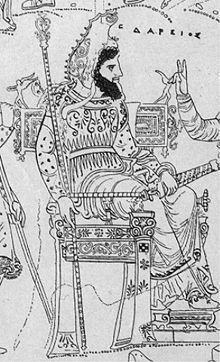- Darius Painter
-
The Darius Painter was an Apulian vase painter and the most eminent representative at the end of the "Ornate Style" in South Italian red-figure vase painting. His works were produced between 340 and 320 BC.
The Darius Painter's conventional name[1] is derived from his name vase, the "Darius Vase", which was discovered in 1851 near Canosa di Puglia and now on display at the Museo Archaeologico Nazionale, Naples (H3253). Many of his works, mostly volute kraters, amphorae and loutrophoroi, are of large dimensions. He most frequently depicted theatrical scenes, especially ones from the Classical tragedies by Euripides,[2] and mythological themes. A number of mythological motifs not represented in surviving literary texts are known exclusively from his vases. On other shapes, especially pelikes, he also painted as wedding scenes, erotes, women, and dionysiac motifs. In contrast to other contemporary painters, sepulchral scenes (manufactory-like workshop, probably at Taras. It is possible that he was the owner or foreman of his workshop. Many vase-paintings are so close to his style, though not by his hand, that they are attributed to his workshop. He was the last important vase-painter in Apulia; Apulian vase painting rapidly declined in quality in the third century. Stylistically, he follows after the Varrese Painter and his group (e.g. the Painter of Copenhagen 4223), but outdoes their achievements. Contemporaries of his that did not simply produce mass wares include the Perrone Painter and the Phrixos Painter. His most important stylistic successor was the Underworld Painter. Arthur Dale Trendall, a key authority on South Italian vase painting, described the Darius Painter as the most important painter of mythological scenes within the total of the South Italian development.
References
- ^ Though many bear inscriptions, no vases in the group attributed to his workshop on the basis of their coherent style are signed.
- ^ The depiction of Darius on his name-vase is possibly derived in its details from the Persae of Phrynikos, C. Anti concluded in 1952, and Schmidt 1960 follows him. However Oliver Taplin notes in Pots and Plays, 2007, p.235-7, the only strong indications of tragic reference are Darius himself and the old man in paidagogos outfit on the plinth inscribed ΠΕΡΣΑΙ, who might be performing the messenger role. Taplin speculates that the iconography of tragedy "could be assimilated into other contexts without danger of confusion", op. cit. p.237.
Sources
- Margot Schmidt. Der Dareiosmaler und sein Umkreis: Untersuchen zur Spätapulischen Vasenmalerei, Munich: Aschendorff, 1960.
- Jean-Marc Moret. L'Ilioupersis dans la céramique italiote, les mythes et leur expression figurée au IVe siècle, Institut Suisse de Rome, 1975.
- Alexandre Cambitoglou, Arthur Dale Trendall. The Red-figured Vases of Apulia, II, Late Apulian, Oxford, 1982: p. 482-522. Bibliography.
- Christian Aellen, Alexandre Cambitoglou, Jacques Chamay. Le peintre de Darius et son milieu, Vases grecs d'Italie Méridionale, Hellas et Roma, Genf 1986.
- Arthur Dale Trendall. Rotfigurige Vasen aus Unteritalien und Sizilien. Ein Handbuch. von Zabern, Mainz 1991 (Kulturgeschichte der Antiken Welt Vol. 47), ISBN 3-8053-1111-7 (p. 85-177).
- Françoise-Hélène Massa-Pairault. Le Peintre de Darius et l'actualité. De la Macédoine à la Grande Grèce, in L'incidenza dell'Antico II: studi in memore di Ettore Lepore, Napoli, 1996.
- Rolf Hurschmann. Dareios-Maler, in Der Neue Pauly Vol. 3 (1997), col. 324.
- Claude Pouzadoux, Guerre et paix en Peucétie à l'époque d'Alexandre le Molosse (notes sur quelques vases du Peintre de Darius), in Le Canal d'Otrante et la Méditerranée antique et médiévale, colloque organisée à l'Université de Paris X - Nanterre (20-21 novembre 2000), Edipuglia, Bari, 2005.
- This article incorporates information from this version of the equivalent article on the German Wikipedia.
Pottery of ancient Greece Wine shapes Perfume shapes and wedding shapes Funerary shapes and cultic shapes Storage shapes Techniques Painters List of Greek vase painters · Amasis Painter · Exekias · Pioneer Group · Douris · Meidias Painter · Euphronios · Darius PainterSpecial topics in Greek pottery Typology · Kalos inscription · Symposium · Corpus Vasorum Antiquorum · John Beazley · Panathenaic Amphorae · South ItalianCategories:- 4th-century BC Greek people
- Ancient Greek vase painters
- Anonymous artists of antiquity
- People from Apulia
- Artists of Magna Graecia
Wikimedia Foundation. 2010.



